Matador Network's Blog, page 6
October 1, 2025
REI Just Made Matching Your Camping Gear and Clothing Way Simpler
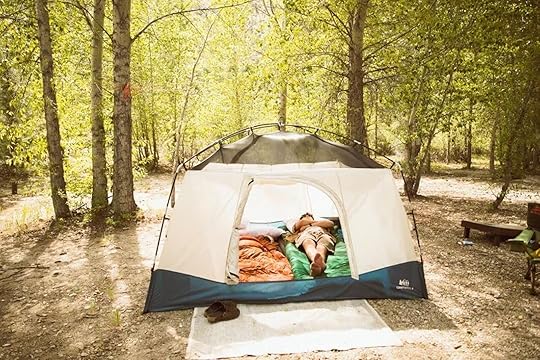
REI just made it easier to build a cohesive collection of camping clothing and gear with the formal launch of the Campwell Collection. This new apparel collection is designed for, as the brand puts it, life beyond the trail, though life on the trail features heavily among what’s offered. Built on feedback from co-op members, Campwell blends functionality with versatile style to create a lifestyle brand that is available both online and in REI stores—pieces meant as much for post-adventure gatherings, campfire nights, or casual days in town. With its mix-and-match approach – think jackets, trail pants, folding cots, and bibs – the line emphasizes comfort and utility.
Just so you know, Matador may collect a small commission from the links on this page if you decide to make a purchase.
As a gear editor at Matador, what most excites me about this launch is that it’s now easier than ever to build a camp setup that is cohesive and designed to function as one large unit. In a recent newsletter I broke down why this philosophy is important, and that’s largely because gear that plays well with others is more dependable when something goes wrong. What REI has done here is effectively rendered redundant my long-homed philosophy for gear shopping (buy stuff that pairs well with your other stuff). When you have a camp chair that’s made by the same company who produced your puffy jacket and your backpack, you can bet that gear was tested in similarly harsh conditions and will hold up equally well during a downpour.
Rather than provide another boring roundup of gear we think you should buy, I want to provide a few examples of the best ways to optmize the Campwell Collection for you by filling multiple holes in your setup in one go.
Browse the REI Campwell Collection
Productive pairings in the new REI Campwell Collection
Photo courtesy REI
First, let’s dress from head to leg (no shoes are available in the collection – yet). Starting at the top, the way I’d shop this collection is to grab the Campwell Beanie and the Campwell Fleece Pullover (available in Men’s and Women’s varieties), and complete that with either the Campwell Rain Jacket or the Campwell Down Jacket, depending on the season I’m stocking for and the location of upcoming trips. The Campwell Flannel, Campwell Henley, and Campwell Pants complete the setup.
Browse the REI Campwell Collection
From another direction, it’s possible to build a basic camp setup from the Campwell Collection. This is built around the Campwell Tent, of course, of which four- or six-person options are available (for single or double occupancies, try the REI Halfdome tent, which I’ve trusted for over a decade and upgraded to a larger size after my daughter was born). Grab the Campwell 30 Sleeping Bag and Sleeping Pad for inside the tent, and the Campwell Chair for outside of it. The Campwell Cooler is a nice thing to have on-hand for cold beverages and snacks, and the Campwell Folding Cot will do you well if you prefer more space between yourself and the ground.
Browse the REI Campwell Collection
Building your setup with the REI Campwell Collection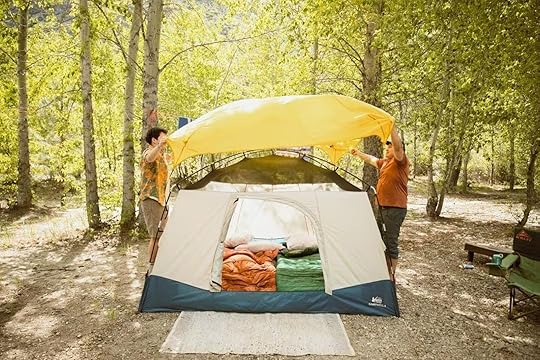
Photo courtesy REI
Of course, you may only need one or two items to complete your gear setup or fill and immediate need. Even if this is the case, the REI Campwell Collection can be a good option for you if your current setup is spread across multiple brands and consistencies of quality, because it provides that starting point for going forward. REI is known to test its in-house products both through professional athletes and its Co-op community, and to make upgrades and changes based on the feedback it receives. This makes it a good brand to trust regardless of the conditions you’re heading out into,
At Matador we’ve tested a swath of REI products over the years, both for outdoor use and more general travel purposes. Here are a few examples that showcase why we trust the brand in such a high regard:
My REI Hiking Socks Are My Security BlanketREI Half Dome Tent Review: The Most Dependable Tent You Can BuyThe Ultimate Summer Backpacking Gear GuideBrowse the REI Campwell Collection
More like thisTravelThe Travel-Ready Running Kit That Got Me Out of the Hotel GymWhere to Play, Eat, and Stay in Chattanooga, Tennessee’s ‘Scenic City’
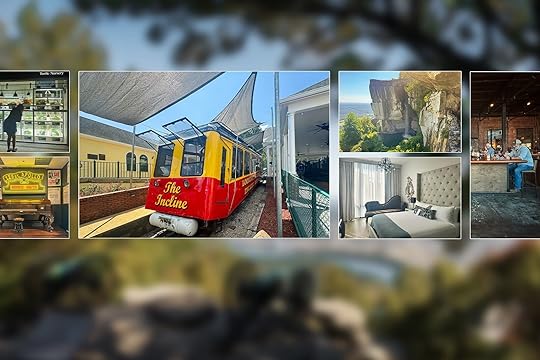
Every city that sees a sharp rise in popularity experiences a golden moment, a phase where it has everything that visitors could want without the consequences of mass tourism. Chattanooga is in that moment now.
As a city dweller flying in from New York City, I hobbled off the plane in Chattanooga expecting a sleepy Southern town. What I found instead was a city with James Beard Award-winning restaurants and an impressive local art scene. The lack of nature in New York City means that I’m always looking for an excuse to get away from the noise and hustle, and Chattanooga delivered that, too, with accessible outdoor options for travelers of all ages and varying abilities.
Two hours from both Atlanta and Nashville, Chattanooga sits in a sweet spot where the mountains meet the river. You can hike to a creek or waterfall in the morning and spend your evenings eating at chef’s tables with the chefs themselves — all without the traffic jams, inflated prices, and pretension of more commonly visited cities.
Things to do in ChattanoogaExplore the Northshore
Left: The Book & Cover. Right: Collective Clothing. Photos: Christa Lei
Chattanooga’s Northshore neighborhood deserves half a day of wandering. Before my trip, I had some concerns about how accessible and queer-friendly the city would be due to Tennessee’s transphobic laws, including a gender-neutral bathroom ban. When I popped into Northshore’s The Book & Cover, which recently took the number two spot on Southern Living’s list of the “Friendliest Places in the South,” I relished the chance to visit an independent bookstore that serves as a safe haven and third space for LGBTQIA+ travelers like myself. For residents and tourists alike, The Book & Cover is a thoughtfully designed space with a wheelchair ramp and gender-inclusive bathrooms where you can order a specialty latte and cozy up with a novel in one of the artfully decorated nooks.
Afterward, I drove to Frazier Avenue — a walkable distance from The Book & Cover but also a convenient four-minute drive — to browse Collective Clothing for vintage and thrift finds. The store is stocked with affordable clothing for all budgets and sizes. As a fat, disabled person, I was delighted to find an embroidered denim shirt for $35, an item that would cost double the price in New York City.
Down the road, I was captivated by Verre Noire, a plant and variety store that stocks unique home goods and houseplants. The entrances are wide and expansive, featuring greenery in a gothic, macabre setting.
Northshore: Frazier Ave & Beyond, Chattanooga, TN 37405
Climb the Incline Railway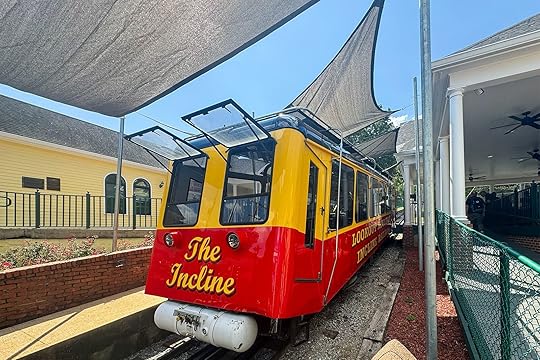
Photo: Christa Lei
Chattanooga’s Incline Railway climbs the side of Lookout Mountain at 72.7 degrees, making it the world’s steepest funicular. The ride is short, and the engineering impressive, with two lookout points at the top.
Chattanooga Tourism Marketing Director Sean Phipps informed me that the Incline Railway used to be the most convenient form of transportation for those living on Lookout Mountain. “People still take the Incline Railway as a commuter option,” he explained, “and it runs until 5 PM.” For those who prefer public transportation, like myself, the Incline Railway provides a charming and functional mode of transit.
Tip: For wheelchair users or anyone squeamish about heights, sit toward the back of the car (closer to where you enter) as there’s space to store walkers and wheelchairs there.
Incline Railway: 3917 St Elmo Ave, Chattanooga, TN 37409
Visit the Bessie Smith Cultural Center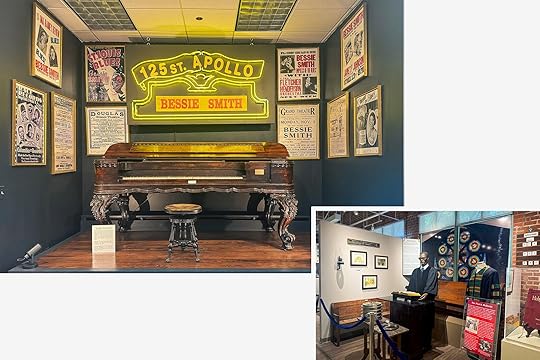
Photos: Christa Lei
To learn more about local history, I stopped by the Bessie Smith Cultural Center, named after the iconic Chattanooga-born Jazz Age blues singer. The cultural center not only preserves the legacy of the“Empress of Blues” but also tells the story of Black history in Chattanooga.
Founded in 1982 by local leaders, the collection provides insight into the contributions and culture that shaped Chattanooga’s development. Vice President of Operations, Elijah Cameron, led a tour and explained the city’s history as a haven for African Americans in the South, where sundown towns were common and unsafe to wander at night.
“Other areas of Tennessee were not safe, but Chattanooga welcomed us with open arms,” he stated, pointing to the center’s recreation of Black entrepreneurship — 9th street — circa the 1960s, before the city displaced the residents. As a person of color, I felt better knowing Chattanooga’s history as a temporary sanctuary.
The city also played a pivotal role in the Civil Rights movement when a group of Howard High School students led peaceful sit-ins at segregated businesses. In response, the city’s police invented the fire hose technique of dispersing a crowd. As a curious traveler, I felt grateful that Chattanoogans dedicate themselves to sharing their entire history with me.
Bessie Smith Cultural Center: 200 E M L King Blvd, Chattanooga, TN 37403
Take a tour of Ruby Falls
Photo: Christa Lei
Ruby Falls drops 145 feet underground and is accessible only through guided tours. It requires comfortable paved walking for about two miles round-trip with some tight cave squeezes, so it’s not fully accessible but is doable if you can handle the distance and don’t mind confined spaces.
As we descended an elevator shaft a couple of hundred feet underground, I was skeptical. How fun could trudging in the dark through damp caves be? I was happy to be proven wrong. Our tour guide’s commitment to entertaining us while providing educational tidbits and trivia about geological formations and the history of the underground falls was impressive. I also found the walk to be slow-paced enough for people who use canes or other assistive walking devices and was surprised to see benches built into the path for visitors to rest.
Included with the price of admission is the viewpoint, which is wheelchair-accessible through an elevator and ramps. The Ruby Falls lookout also has a colorblind viewer so everyone can experience the panoramic views.
Ruby Falls: 1720 S. Scenic Highway Chattanooga, TN 37409
Stroll through Rock City Gardens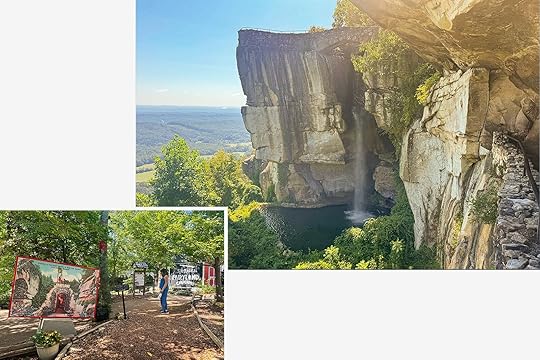
Photos: Christa Lei
Rock City Gardens sprawls across many acres as a former residence. The whimsical gardens feature massive rock formations, a 140-foot waterfall, and a point where you can supposedly view seven states. There are many trails within the complex, including an ADA trail that accommodates wheelchairs and scooters.
A must-visit is the Fairytale Caverns trail, which is enclosed and decorated with technicolor-painted handmade wooden figurines and highlights various fairytales through dioramas. I felt like a child again, as I oohed and aahed my way through Jack and the Beanstalk and Cinderella. The majority of the park, with the exception of Fat Man’s Squeeze, is easily strollable and perfect for families, with plenty of spaces to sit and rest.
Rock City Gardens: 1400 Patten Rd, Lookout Mountain, GA 30750
Check out the Sculpture Fields at Montague Park
Photo: Christa Lei
For more art, the Sculpture Fields at Montague Park is a 33-acre public-access park (free!) filled with large-scale sculptures by renowned artist John Henry. It also features a rotating and permanent collection of Henry’s colleagues and friends, including New York sculptor Mark di Suvero, among other prolific names.
A comparable sculpture park in upstate New York charges admission and doesn’t allow animals. Here, you can bring your dog, have a picnic, and explore the collections at no cost. Even better, while most sculpture gardens forbid visitors from touching the art, the Sculpture Fields encourage play and touching. Visitors can sit on Bench No. 9, which is described as “practical art,” and admire the work while engaging with it.
Sculpture Fields at Montague Park: 1800 Polk St, Chattanooga, TN 37408
Spend an afternoon at the Tennessee Aquarium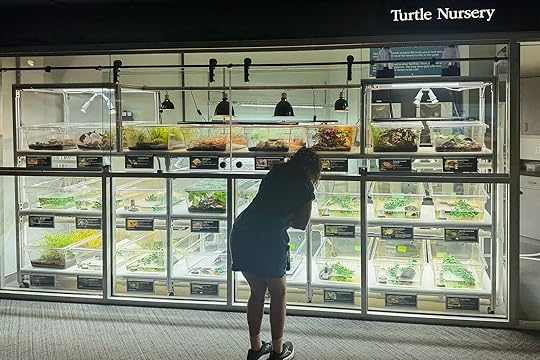
Photo: Christa Lei
The Tennessee Aquarium sits on the banks of the Tennessee River and showcases how central nature is to Chattanooga. The conservation focus is prominent through a genuine commitment to protecting freshwater and marine ecosystems. Director Thom gave us a behind-the-scenes tour that revealed the serious science and conservation efforts happening there.
Before moving into the exhibits, the building orients visitors toward the river to show how their visit contributes to conservation. I met the aquarium’s resident turtle expert who allowed my group to walk through the hatchery, explaining the breeding programs for endangered species.
The aquarium is easily accessible via wheelchair with elevators, a main pathway accommodating wheelchairs, and thoughtful architecture. The aquarium’s interactive exhibits — including interactive educational games and touch tanks — make difficult topics accessible for all, including children, to understand.
Tennessee Aquarium: 1 Broad St, Chattanooga, TN 37402
Where to eat and drink in Chattanooga2nd American Restaurant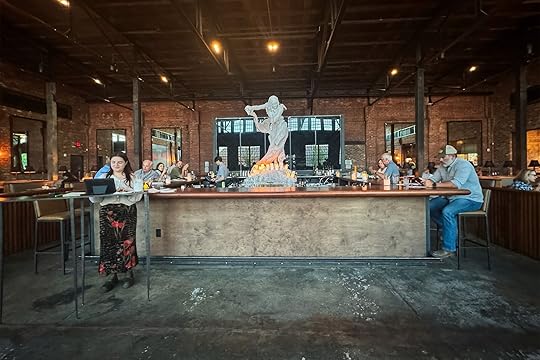
Photo: Christa Lei
On my first evening in Chattanooga, I enjoyed a dinner at Chef Daniel Lindley’s 2nd American Restaurant, a convivial venue set in a former warehouse, retaining its brick structure and original beams but adding a splash of drama with a central sculpture by a local artist. The entire dining room is a sight to behold, accented with epic fine art by local Chattanooga artists.
Our server explained that Chef Lindley wanted to create a warm, welcoming atmosphere inspired by his Sunday childhood dinners. Every entree includes a communal bowl of mashed potatoes, and everyone shares side dishes in the same way: family style. I’d recommend coming here with a large group so you can try everything. The highlights were the tomato pie, which reminded me of a Southern approximation of Chicago deep-dish pizza, but featuring locally grown heirloom tomatoes sourced from Amish farmlands nearby. If you can, save room for dessert — I left stuffed and took home my fried peach pie with miso caramel.
2nd American Restaurant: 1601 Cowart St, Chattanooga, TN 37408
Main Street Meats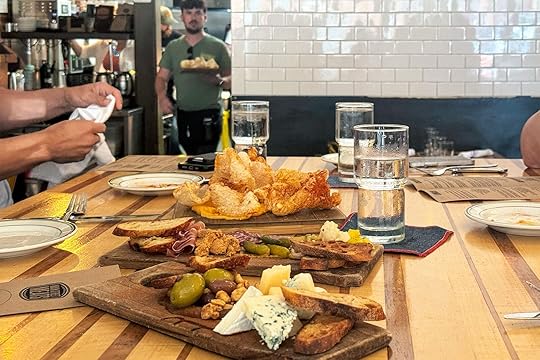
Photo: Christa Lei
At lunch another day, I ate at Main Street Meats, where the chef-restaurateur, Eric Niel, walked me through his menu, recommending his pork rinds as a “sleeper hit.” He also explained the differences in his other restaurant concepts (both local): the James Beard favorite Easy Bistro and his newest venture, Little Coyote. Chef Niel was born and raised in Louisiana but came to Chattanooga after culinary school and settled down in the city with his wife.
“I noticed a lack of fine dining options and lack of farm-to-table,” he confessed, “so I opened Easy Bistro to fill the gap, with Main Street Meats being my second, more casual concept.”
The restaurant doubles as a butcher shop, sourcing from local farms around the Tennessee Valley. Despite the high quality of the meat, I was more surprised by how tasty the sides were. Vegans and vegetarians will be happy here — I inhaled the warm potato salad, happily munched on the broccolini, and devoured my side of fresh melons.
Main Street Meats: 217 E Main St, Chattanooga, TN 37408
1885 Grill
Photo: Christa Lei
Another lunch option is 1885 Grill in the historic St. Elmo neighborhood. For the last decade or so, the restaurant has racked up accolades for having the best wings in Chattanooga — literally. There’s a counter piled with their repeated victories, and I can confirm that the restaurant serves excellent wings, without the markup or pretension. I recommend sharing the wings — they don’t need a side sauce though they do have blue cheese and ranch dressing — and getting a cup of gumbo for lunch.
1885 Grill: 3914 St Elmo Ave, Chattanooga, TN 37409
Clumpies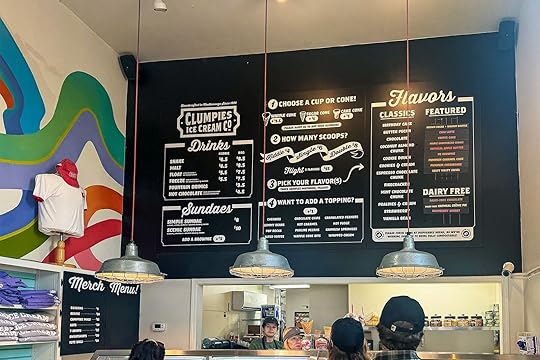
Photo: Christa Lei
For artisanal, homegrown ice cream, Clumpies has three locations in Chattanooga. The scoops are gigantic, and the flavors span from conventional (vanilla, chocolate, etc.) to creative (firecracker, salty malty pretzel, etc.). Expect others when you go; the chain is swamped for good reason — it’s a tasty way to cool off during the hot summers.
Clumpies: Various
Where to stay in Chattanooga:The Edwin Hotel

Photo: Christa Lei
I checked in at The Edwin Hotel, part of the Marriott Autograph Collection. The hotel sits at the southern end of the historic Walnut Street Bridge, a pedestrian walkway that spans downtown Chattanooga and connects it to the bohemian North Shore neighborhood. This upscale five-story boutique hotel highlights local art by local Chattanooga artists, which you can purchase or inquire about through the QR codes next to each work.
One of the staff members, Alden, was helpful in running over Chattanooga’s must-sees with me, and he upgraded me to a corner room overlooking downtown. My room featured a king-size bed, floor-to-ceiling windows that overlooked the pedestrian bridge, and a Victorian fainting couch. When I wasn’t in my room, I imbibed at the rooftop Whiskey Thief bar, which is award-winning not only for its cocktails but also for the views. The Edwin also has a coffee shop, Provisions, in the lobby and a full-service restaurant and bar called Whitebird. If you ask, they can provide complimentary bicycles for exploring the city. Note: The pedestrian bridge will be under construction until 2026.
If you’re looking for a quirkier accommodation, The Hotel Chalet offers suites in converted authentic Pullman train cars. For the full Chattanooga Choo Choo experience, you can sleep on the former station’s railroad.
The Edwin Hotel: 102 Walnut St, Chattanooga, TN 37403
Getting to and around Chattanooga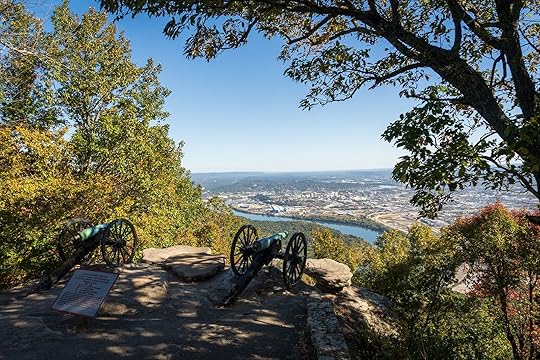
Photo: Zack Frank/Shutterstock
The easiest way for me to get to Chattanooga from New York City was by flying. Delta has two direct flights from LaGuardia Airport (LGA) a day, which makes travel relatively pain-free. The airport has a large, wheelchair-accessible terminal with plenty of space to eat and take breaks.
I’d recommend renting a car while in Chattanooga, as it’s the easiest mode of transportation with the highways, and parking is abundant and affordable. However, rideshares are available, and the local transit authority, CARTA, provides public transportation for the city through fixed bus routes and a free all-electric shuttle system between downtown Chattanooga and the Northshore neighborhood. Otherwise, CARTA fees vary from $0.75 for senior citizens, students, and people with disabilities up to $2 for CARTA GO (an on-demand bus service) for one-way rides. Passes, routes, and rates are available on the CARTA website, which also states accessibility and paratransit options.
The most walkable neighborhoods are St. Elmo, downtown Chattanooga, and the Chattanooga Choo Choo district — however, I still recommend renting a car for the best ease of access to Chattanooga’s resources. 
Taipei: Where Ancient Temples and Tech Giants Thrive Side by Side
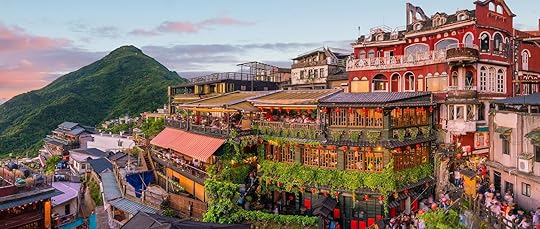
Taipei doesn’t rush to define itself. It’s both a global tech hub where 5G networks hum above centuries-old Taoist chants drifting from temple courtyards. The capital trades in microchips and meditation in equal measure. Beneath LED-lit towers and the circuitry of its semiconductor empire, traditions remain intact: slow, analog, often quiet. That coexistence gives the city its character. Unlike many urban centers with futuristic skylines, Taipei doesn’t conceal its past to make room for progress. It places the old beside the new, letting both breathe.
For travelers, Taipei offers a rare chance to live inside this duality. You taste it in a bowl of beef noodle soup followed by craft coffee, see it in century-old temples standing beside neon-lit towers, and feel it on a trek through the tea hills just beyond the skyline.
Where migrations shape a living city
Photo: Shawn.ccf /Shutterstock
Taipei’s identity has been shaped by layers of migration. Indigenous Austronesian communities lived here long before national borders existed. Han Chinese settlers arrived during the Ming and Qing dynasty in the 1600s, followed by the Japanese colonial period from 1895 to 1945, which continued and preserved hot spring bathhouses in Beitou, red-brick shophouses, and rail lines that still cross the city.
After 1949, Mandarin became the dominant language. Today, people in Taipei slide between Taiwanese Hokkien, Mandarin, and Hakka, with Japanese and English heard regularly in public life and in the city’s street food(tān wèi) stalls and markets. Religious beliefs are just as diverse, with Taoist temples, Buddhist monasteries, and Christian churches often within a few city blocks of each other. Taipei’s diversity is not a marketing tagline, it’s a structural condition.
Taken together, these layers make Taipei an ideal first stop in Asia that’s compact yet reveals how cultures converge and evolve side by side.
A tech hub with a human rhythm
Photo: f11photo /Shutterstock
Taipei is often defined by its technical prowess. Taiwan Semiconductor Manufacturing Company (TSMC), one of the world’s most valuable tech firms, maintains key offices and corporate operations in the city, the city plays a foundational role in the global electronics ecosystem. Smartphones, AI systems, and electric vehicles all rely on chips produced in or nearby Taipei. Yet what shapes Taipei’s atmosphere isn’t just what it builds — it’s the rhythm of how the city moves.
For all its innovation, Taipei moves at a humane pace. Trains arrive on time and commuters rarely jostle. Coffee shops stay open late, more often filled with readers and students than business people. You can ride the MRT to a hiking trailhead in 30 minutes, or walk from the Taipei International Convention Center (TICC) near TAIPEI 101 to a food tour, such as taro balls and hot and sour soup. That juxtaposition of circuitry and stillness is the kind of natural design that emerges only in a true global hub.
Rituals of calm in an engineered world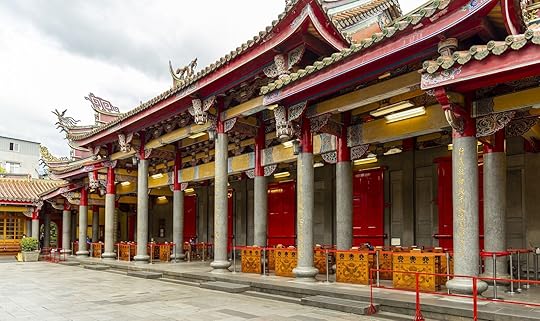
Photo courtesy Travel Taipei
Encircled by mountains and carved with rivers, natural escapes are always visible in Taipei: the green folds of Yangmingshan National Park’s dormant volcanos rise to the north, while the Taipei Basin stretches south. Taiwan is home to more than 100 natural hot springs sources, some of the easiest to reach are in Beitou, it takes about 40 minutes by MRT from Taipei Main Station to Xinbeitou. Beitou’s Japanese colonial-era bathhouses have largely modernized, but the ritual remains. Locals soak in sulfur pools beneath cypress beams, moving from hot to cold, then rest under fans with herbal tea. Here, soaking is thermal relaxation woven into everyday life as much as it is a luxury.
Calm takes other forms elsewhere in the city. In the mornings, tai chi groups gather in Daan Forest Park to practice their craft. Evening temple visits for offerings and incense are common in Taipei as a way to unwind after the day. One of the most visited is Xingtian Temple, built in 1967 and dedicated to Guan Gong, the deity of loyalty and business. It draws everyone from elderly devotees to young professionals, many of whom come not only to pray, but also to consult with fortune tellers in nearby arcades.
Fortune-telling in Taipei is less theatrical and more therapeutic than in the West. A session might blend palm reading with numerology and practical life advice. In a city that prizes systems — engineering, software, logistics — there is still room for the ineffable. For those navigating major decisions, it offers a non-digital form of clarity.
Neighborhoods best explored on foot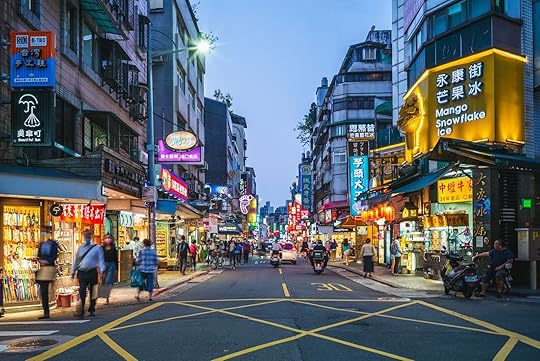
Photo: Richie Chan /Shutterstock
In a rarity for major cities, Taipei’s streets reward the unhurried. Some of the most compelling experiences come not from landmarks, but from walking without an agenda. Stroll with a notebook or sketchpad in hand, a little cash in your pocket, and leave room for detours — whether that’s a street vendor snack or a spontaneous stop for a cold Taiwan Beer.
On Dihua Street (Dadaocheng) in Taipei’s Old Town, 19th-century warehouses and trading houses now function as boutiques, design studios, and tea houses. Lin Mao Sen Tea Company, founded in 1883, continues to operate here. Staff pour tastings of high-mountain oolong and baozhong tea on its long wooden counters. Just a short walk away, bars mix highballs with smoked lapsang souchong, creating distinctly Taiwanese craft cocktails. Other streets, like Yongkang Street and Fujin Street, blend Japanese minimalism with Taiwanese functional aesthetics, their cafés, bookshops, and galleries speaking a design language that feels global without being generic. Across these neighborhoods, the aesthetic leans understated. Taipei doesn’t seek to impress with extravagance; it invites people to slowly experience and understand it.
A city built for access and ease
Photo: Richie Chan /Shutterstock
Part of Taipei’s approachability lies in its infrastructure. The MRT is inexpensive, efficient, and remarkably clean (eating and drinking are prohibited inside stations). Signage is in Mandarin and English. Free public Wi-Fi is common. Taxis run on meters, no bargaining required, and most businesses accept cards or and mobile payment. For a first-time visitor, the barrier to entry is low.
What keeps it authentic, though, is how little it performs for outsiders. The night markets — Raohe, Ningxia, Shilin — aren’t stage sets, but working economies where residents line up for pepper buns and crispy fried chicken cutlets. Temples double as civic centers, posting calendars for festivals, rites, and community classes. That lack of pretense opens the door to a deeper kind of travel that invites longer stays and repeat visits. In short, Taipei respects the intelligence of the traveler.
Taipei’s modernity is often misunderstood by those expecting chrome skylines or curated shopping districts. The city’s actual innovation is more subtle: the way complexity is absorbed into daily life without friction, engineering comfort without excess. Technology here allows more room for human connection, whether that means soaking in a hot spring, wandering heritage lanes, or lingering in a tea house where conversation drifts as slowly as steam from the kettle. While many cities compete for attention through vertical spectacle, Taipei remains horizontal in spirit. Its story doesn’t shout. But it’s worth listening to in person to truly understand. 
September 30, 2025
13 New Hotels You’ll Want to Plan Your Entire Trip Around

September isn’t typically known for marquee hotel openings, but this month is packed with global debuts. In New York, the Waldorf Astoria returns after an eight-year, $2 billion restoration, with Chef Michael Anthony’s reimagined Waldorf salad is reportedly worth booking a room for. Across town, Faena’s dazzling arrival on the High Line caused quite a stir, bringing the brand’s signature mix of art, dining, and theater to Manhattan. In London, The Chancery Rosewood’s billion-pound transformation of the former US Embassy now houses the first European Carbone — already one of the city’s toughest reservations. And those are just the headliners: Sydney gets Australia’s first 25hours inside a revived Paddington theatre; Istanbul welcomes Aliée on the Golden Horn with a sweeping wellness complex; Sonoma’s Appellation Healdsburg opens as Charlie Palmer’s flagship, featuring a calendar of artisan workshops and immersive food programs; and Palm Springs’ Casa Palma reinterprets a Hollywood-era retreat with Mediterranean design.
Consider this your cue to start planning fall travel around some of the year’s most anticipated hotel openings.
25hours Hotel Sydney The Olympia
Rendering: 25hours Hotels/Tonkin Zulaikha Greer
Location: Sydney, AustraliaWhy it’s notable: Australia’s first 25hours Hotel, reviving a historic Sydney theater with a cinematic design ethos and destination diningType of traveler who will love this hotel: Culinary aficionados, the culturally curiousPrice: From $22525hours Hotel The Olympia, the brand’s first property in Australia, is set within a heritage-listed former theatre in Sydney’s Paddington. The 109 rooms, split into “Dreamer” and “Renegade” categories inspired by cinematic archetypes, each feature original artwork by the Sydney painter, Kubi Vasak. Culinary director Mitch Orr, a leading figure in the city’s restaurant scene, oversees four venues: The Palomar, the first international outpost of London’s acclaimed Middle Eastern–influenced restaurant; The Mulwray, a cocktail and wine bar named after a character in the film Chinatown; Jacob The Angel café; and Monica, a 1960s Hollywood-inspired rooftop bar. Located just three kilometers from the CBD, the hotel sits at the junction of Paddington, Surry Hills, and Darlinghurst, positioning it as both a cultural stay for visitors and a lively hub for locals.
Book NowAliée Istanbul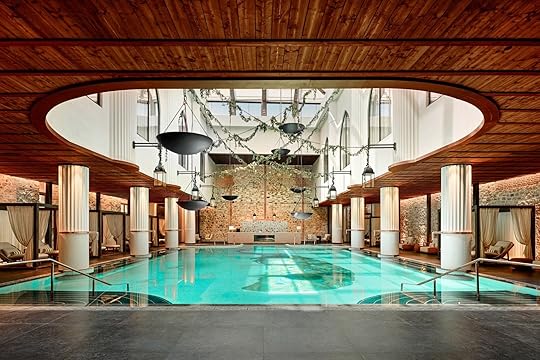
Photo: Aliée Istanbul
Location: Istanbul, TurkeyWhy it’s notable: Paris Society’s Istanbul debut, combining large-scale wellness facilities with a Michelin-starred dining programType of traveler who will love this hotel: Culinary aficionados, wellness wanderersPrice: From $790On Istanbul’s Golden Horn, Aliée Istanbul occupies restored dockyard buildings in the historic Tersane district. The 122 rooms and suites range from stone-walled spaces with soaring ceilings to garden-facing accommodations, all with access to the hotel’s shorefront Swim Club, which features a lagoon pool, Olympic lap pool, and waterfront lawns. The wellness offering is ambitious: Aliée Well⁺ spans 4,000 square meters and includes marble hammams, a Russian banya, cold plunges, cryotherapy, oxygen therapy, and a Longevity Clinic offering genetic and microbiome analysis. The six dining venues include Taste by three-Michelin-starred German chef Thomas Bühner; a Belle Époque–inspired cabaret supper club; a waterfront pizzeria with a copper oven; and a tea lounge serving rare blends curated by in-house sommeliers. As part of the Paris Society portfolio, the hotel also connects guests to Istanbul through private yacht trips on the Golden Horn, market tours with chefs, and studio visits with local artists and designers.
Book NowAppellation Healdsburg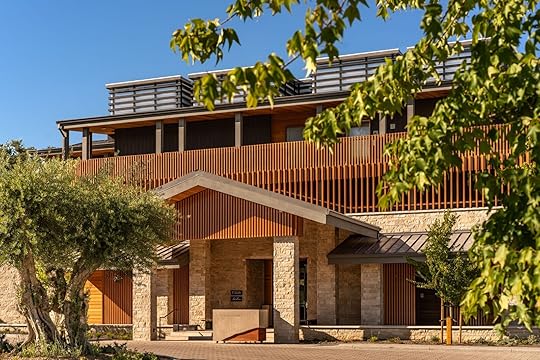
Photo: Appellation Healdsburg
Location: Healdsburg, CaliforniaWhy it’s notable: The flagship of Charlie Palmer’s new brand, built to showcase Sonoma’s food and wine cultureType of traveler who will love this hotel: Culinary aficionados, the culturally curiousPrice: From $509In the heart of Sonoma County, Appellation Healdsburg has opened as the flagship hotel of the new brand co-founded by chef Charlie Palmer and hospitality veteran Christopher Hunsberger. The 108-room resort spans eight acres with landscaped gardens, two pools, expansive event spaces, and the Terroir Spa, which incorporates local botanicals into its treatments. Folia Bar & Kitchen showcases open-fire cooking led by Reed Palmer, a Healdsburg native with experience at Blue Hill and Stone Barns, while the rooftop pairs vineyard views with inventive small plates and cocktails. Guests can also take part in Crafted at Appellation, a year-round calendar of workshops with regional artisans, ranging from cheesemaking to botanical mixology. Guestrooms and suites — all with outdoor space — are stocked with local pantry goods and a complimentary bottle of Sonoma wine.
Book NowCasa Palma
Photo: Casa Palma
Location: Palm Springs, CaliforniaWhy it’s notable: A Palm Springs classic reimagined with Mediterranean design and outdoor recreationType of traveler who will love this hotel: Family vacationers, wellness wanderersPrice: From $180Casa Palma Hotel & Bungalows, now fully open with 33 rooms, sits one mile from downtown Palm Springs on land originally developed in the 1940s as a secluded retreat by Hollywood icon Errol Flynn. The design marries mid-century modernism and Mediterranean influence — a bright white façade, bougainvillea accents, and Greco-inspired tile stairs — with interiors in seafoam and slate tones, natural wood, woven textures. The property features two pools outfitted for water volleyball and basketball, a full-size court with pickleball overlays, expansive lawns for yoga or picnics, fire pits and barbecue zones, bikes for riding into town, and a fitness center. The signature restaurant, Chiquita, serves Mediterranean-inspired dishes indoors and al fresco, with views of the San Jacinto Mountains.
Book NowFaena New York
Photo: Faena New York
Location: Manhattan, New YorkWhy it’s notable: Alan Faena’s long-awaited New York debut, uniting hospitality with art and performance in a landmark Chelsea towerType of traveler who will love this hotel: The culturally curious, money-is-no-object travelersPrice: From $1,550Faena has brought its theatrical brand of hospitality to Manhattan with the opening of Faena New York, a 120-room property inside Bjarke Ingels Group’s twisting One High Line towers overlooking the Hudson River. Designed in collaboration with Peter Mikic, the interiors channel old New York glamour through bold patterns, gilded details, and large-scale artworks, including a monumental Diego Gravinese mural in the lobby. At the center of the property is La Boca, Francis Mallmann’s restaurant where Argentine fire cooking meets live performance, alongside the Living Room, a lounge and gallery space featuring a Keith Haring original. Future additions will include Tierra Santa Healing House, a 12,000-square-foot spa set to open later this year, and Faena Theater, slated for 2026. True to the brand’s identity, the property blends luxury hospitality with art, design, and performance — positioning itself as both a hotel and a cultural venue.
Book NowHotel Indigo Gatlinburg Downtown
Rendering: IHG
Location: Gatlinburg, TennesseeWhy it’s notable: The only hotel in Gatlinburg with a rooftop restaurant and bar overlooking the Great SmokiesType of traveler who will love this hotel: Adventure enthusiasts, family vacationersPrice: From $179In Gatlinburg, the new Hotel Indigo Gatlinburg Downtown marks the brand’s 175th global opening with 136 rooms, an infinity-edge pool, and the tallest rooftop venue in the city. Designed by SK Ballard Contract Interiors, the design combine Art Deco elements with mountain-inspired textures and photography by East Tennessee artists. Altitude Restaurant and Rooftop Bar serves New American dishes made with locally sourced ingredients and regional craft cocktails with panoramic views of the Smokies. Other amenities include 9,300 square feet of event space, a fitness center with Peloton bikes, and dog-friendly rooms. With the park entrance just minutes away, the hotel positions itself as both a stylish base for outdoor adventure and a social hub in Gatlinburg.
Book NowLimelight Boulder
Photo: Limelight Boulder/Lowfield
Location: Boulder, ColoradoWhy it’s notable: Largest all-electric hotel in the countryType of traveler who will love this hotel: Adventure enthusiasts, sustainability-focused travelersPrice: From $270On the CU Boulder campus, Limelight Boulder has opened as the largest all-electric hotel in the US, with 252 rooms and 26,000 square feet of event space. Built to LEED Gold standards, the property was designed by WATG, with interiors by Meyer Davis and HBA San Francisco, incorporating curated art and framing views of the Flatirons and downtown. A rooftop pool with mountain panoramas, fire pits, coworking spaces, and a game room shape its communal areas, while Ajax Tavern brings Aspen’s après culture to Boulder under executive chef Jeff Gundy. The property also features Crepe Therapy Café from James Beard–honored chef Mawa McQueen. The hotel introduces brand programs such as Limelight Live, showcasing local and touring musicians, and Adventure Architects, which pairs guests with in-house experts to build custom itineraries across Boulder’s trails, food scene, and cultural highlights.
Book NowMama Shelter Singapore
Photo: Mama Shelter Singapore
Location: SingaporeWhy it’s notable: The first Mama Shelter in Asia, bringing the brand’s playful design and nightlife culture to SingaporeType of traveler who will love this hotel: Family vacationers, the culturally curiousPrice: From $190In Singapore’s Somerset district, Mama Shelter makes its Asian debut with 115 rooms, with lively dining and entertainment at its core. The ground-floor restaurant and bar, led by chef Eugene Chan, doubles as a social hub, featuring a ceiling-spanning mural painted on-site by Parisian street artist Beniloys. Upstairs, the rooftop adds Mediterranean fare, two pools, and late-night DJ sets. Nearly half of the rooms feature terraces, and the brand’s first bunk options make it easy for families or groups. Designed by Dion & Arles, the interiors draw on Singaporean traditions with Peranakan-inspired tilework, stained glass, animal motifs, and playful textiles. Mama Shelter’s arcade games, weekly live performances, and pet-friendly atmosphere are likely to draw locals as much as visitors.
Book NowResidence Inn Reno South
Rendering: Marriott
Location: Reno, NevadaWhy it’s notable: A locally owned extended-stay hotel with resort-style outdoor amenitiesType of traveler who will love this hotel: Family vacationers, adventure enthusiasts.Price: From $167At the foot of the Sierra Nevada, Residence Inn Reno South brings 128 extended-stay suites to South Reno’s growing business and entertainment district. Owned by the Pegram and Carano families, longtime figures in Nevada hospitality, the hotel sits next to the Tamarack Casino and is within easy reach of Lake Tahoe, Mt. Rose Ski Resort, and downtown Reno. Each suite includes a full kitchen and living area, with connecting options available for families. Guests have access to a heated pool and whirlpool with mountain views, practice on the putting green, or gather at the outdoor firepits. A Peloton-equipped fitness center, 24-hour laundry, and complimentary breakfast round out the amenities.
Book NowSir Devonshire Square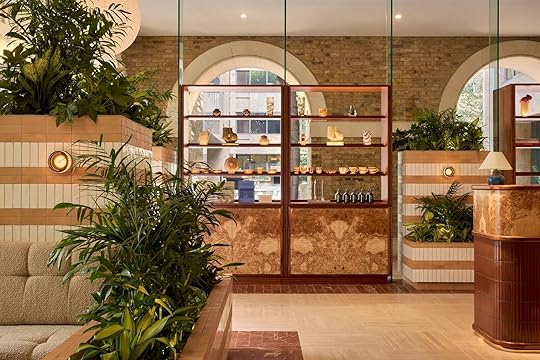
Photo: Sir Hotels
Location: London, EnglandWhy it’s notable: Sir Hotels’ first London property, set in a restored 17th-century textile warehouse in Devonshire SquareType of traveler who will love this hotel: The culturally curiousPrice: From $290The Amsterdam-based Sir Hotels group has chosen a 17th-century warehouse in East London’s Devonshire Square for its first London address. Interiors by Maison 191 draw on Bauhaus geometry, the textile work of Anni Albers, and mid-century architects Quincy Jones and John Lautner, with terracotta tiling, arched windows, and custom-designed furniture in deep blue, green, and earthy tones. Rooms overlook Devonshire Square and the city skyline, offering a quiet retreat above one of London’s liveliest districts. A rotating gallery wall in the lobby highlights emerging artists, while the Sir Shop features pieces by local makers. The all-day brasserie serves seasonal plates, with a flagship restaurant and private members club, The Cover, still to come.
Book NowSkaneateles Fields Resort & Spa
Photo: Skaneateles Fields Resort & Spa
Location: Skaneateles, New YorkWhy it’s notable: A wellness-focused resort with a strong culinary pedigree in the Finger LakesType of traveler who will love this hotel: Culinary aficionados, wellness wanderersPrice: From $199In New York’s Finger Lakes, Skaneateles Fields Resort & Spa offers 89 rooms and suites on 100 acres. Amenities include a year-round outdoor pool, an indoor pool, saunas, pickleball and bocce courts, a nine-hole executive putting green, fire pits, and miles of trails. A shuttle also runs to the village of Skaneateles. The property’s signature restaurant, Fields, is led by executive chef Esperanza Guzman in partnership with the nearby Tap Root Fields farm. The bar program is overseen by William Elliott — the James Beard Award–winning bar director behind Brooklyn’s Maison Premiere — whose latest project, Tigre, has drawn national buzz. The result is a resort that fuses serious wellness — including a salt chamber, hot–cold plunges, a yoga studio, and full spa — with a strong culinary perspective, all backed by Curio Collection by Hilton perks.
Book NowThe Chancery Rosewood
Photo: Rosewood
Location: London, EnglandWhy it’s notable: One of the year’s most anticipated UK hotel openingsType of traveler who will love this hotel: Luxury travelers, the culturally curiousPrice: From £1,200The hottest reservation in London this year, The Chancery Rosewood has reopened Eero Saarinen’s 1960 former US Embassy as a 144-suite hotel after a seven-year, billion-pound transformation led by Sir David Chipperfield with interiors by Joseph Dirand. Its dining program spans eight venues, including the first European Carbone, TOBI MASA by Masayoshi Takayama, and Eagle Bar, a seventh-floor terrace overlooking Mayfair. The subterranean Asaya Spa includes a 25-meter pool, sauna, steam room, and the Taktouk Clinic, led by London dermatologist Dr. Wassim Taktouk. An art collection of more than 700 works, with commissions by Christopher Le Brun and Anthony Grace, underlines the property’s ambition as a new cultural landmark for the capital.
Book NowWaldorf Astoria New York
Photo: Hilton
Location: New York City, New YorkWhy it’s notable: Iconic landmark reopens after an eight-year, $2 billion restorationType of traveler who will love this hotel: Luxury travelers, the culturally curiousPrice: From $1,600The Waldorf Astoria New York — “the greatest of them all,” in Conrad Hilton’s words — has reopened after an eight-year, $2 billion restoration that transformed the 1931 Art Deco tower into 375 of Manhattan’s largest guest rooms and suites, along with 372 private residences. Architecture firm SOM and designer Pierre-Yves Rochon oversaw the meticulous preservation and restoration of landmark interiors. Guests can now book the hotel’s three dining venues: Lex Yard, a brasserie from Chef Michael Anthony; Yoshoku, a Japanese concept with a kaiseki-style tasting menu; and the revived Peacock Alley. Other highlights include the Guerlain Spa (opening soon), 43,000 square feet of restored event space including the Grand Ballroom, and a discreet porte-cochère entrance on 49th Street — the only one of its kind in Manhattan.
Book NowMore like thisTravelPlanning a Fall Foliage Trip? Here’s Why Colors Vary in Each US Region and What to Expect10 Haunted Airbnbs Guests Can’t Get Enough of in 2025

Airbnb has released its top 10 most haunted stays for 2025 — a coast-to-coast collection of historic homes and pop-culture sets where a peaceful night’s sleep might be hard to come by. This year, Salem, Massachusetts, is the fastest-rising Halloween destination on the platform, with double-digit growth in searches for the holiday weekend. New Orleans, meanwhile, remains the country’s undisputed paranormal capital — its Garden District mansions and centuries of ghost lore continue to draw travelers and deliver some of the highest Halloween earnings for local hosts. On the West Coast, San Bernardino, California, has become a Halloween draw thanks to a massive EDM festival and a cluster of reputedly haunted houses.
As Halloween travel surges, so does fascination with Airbnbs said to be haunted. There’s a third-floor bedroom in New Orleans where visitors have reported sightings of a young girl in a yellow 1890s dress; a St. Paul manor once voted the city’s “most mysterious house”; and a former Missouri morgue turned vacation loft that lends out paranormal research gear. Others are famous for the scares they delivered on screen, including California’s original Poltergeist house, Oregon’s Twilight Swan house, the Georgia home used as Caroline Forbes’ residence in The Vampire Diaries, and a Byers family replica near Atlanta that recreates the world of Stranger Things — right down to the blinking Christmas lights.
If the idea of a claw-foot tub that fills on its own or a music box that starts playing at 3 AM doesn’t send you packing, these are the most haunted Airbnbs for 2025.
More like thisTravelPlanning a Fall Foliage Trip? Here’s Why Colors Vary in Each US Region and What to ExpectWe hope you love the haunted airbnbs we recommend! Just so you know, Matador may collect a small commission from the links on this page if you decide to book a stay. Listed prices are accurate as of the time of publication.
Parks-Bowman Mansion: The Haunted Bedroom — New Orleans, Louisiana Photo: Courtesy of Airbnb Community
Photo: Courtesy of Airbnb Community Photo: Airbnb
Photo: Airbnb Photo: AirbnbSee more photos
Photo: AirbnbSee more photosThe Parks-Bowman Mansion sits in the middle of New Orleans’ Garden District, a short walk from Lafayette Cemetery and the St. Charles streetcar. The house dates to the late 1800s and today operates as a multi-room Airbnb. According to the hosts, one of the mansion’s original daughters — a young girl who died in the 1890s — has been seen for decades in a yellow dress, often on the upper porch or in the hallway outside the third-floor bedroom. The hosts don’t promise an encounter, but they do share plenty of New Orleans lore over morning coffee in the shared kitchen.
Two guests, one bedroom
Price: $147 per night
 Photo: Airbnb
Photo: Airbnb Photo: Airbnb
Photo: Airbnb Photo: Courtesy of Airbnb CommunitySee more photos
Photo: Courtesy of Airbnb CommunitySee more photosKnown locally as Saint Paul’s “most mysterious house,” this three-story home has drawn paranormal investigators for years with reports of cold drafts, sudden knocks, and faint figures appearing in the upstairs hallway. Host Sean says that a young girl named Rosalia Fihn died here of typhoid fever in the early 1900s. After moving in, he found a child’s hair barrette on the floor and recalls picturing a girl in a white dress — whom he believes to be Rosalia. Guests now describe a palpable energy near the closet in her old room. Even the resident Doberman, Scorch, has been known to bark at empty hallways. The Airbnb room itself is spacious, with tall windows, a queen bed, and direct access to the original master bath
Two guests, one bedroom
Price: $99 per night

Photo: Airbnb
See more photosHow do you feel about sleeping in a former morgue? This historic building in Ozark, Missouri, once served as the town morgue and funeral home — and today it’s a nationally recognized historic site that welcomes overnight guests. The interior is now a spacious loft apartment with vintage furniture and cheeky, mortuary-themed decor. You’ll find a king bed, kitchen, and claw-foot tub. The host fully embraces the building’s past, providing ghost-hunting equipment like an EMF detector, spirit box, and dowsing rods. Numerous professional paranormal teams have investigated here and reported unexplained voices and shadowy figures. The Airbnb listing even boldly warns: “No refunds if you leave mid-stay because you got scared.”
Six guests, one bedroom
Price: $99 per night
 Photo: Courtesy of Airbnb Community
Photo: Courtesy of Airbnb Community Photo: Airbnb
Photo: Airbnb Photo: AirbnbSee more photos
Photo: AirbnbSee more photosYou can’t talk about haunted stays without mentioning Salem. The Henry Derby House, an 1838 home in the McIntire District, has quite the reputation among locals and guests. Once the residence of a tailor, it now welcomes brave travelers looking for a brush with the paranormal. Owner Phil Marchand even adds a playful disclaimer to the listing: “It’s an antique house over 180 years old…the stairs creak, the windows rattle, and you may experience paranormal activity during your stay.” Guests report phantom footsteps pacing the empty third floor, scratching on bedroom doors, unexplained knocks, and even a bed that shakes on its own. One visitor claims they saw a teenage girl with long dark hair in an upstairs hallway, while another swears they felt a ghostly cat walking across the bed — despite no live cat in the house.
12 guests, seven bedrooms
Price: $595 per night
 Photo: Airbnb
Photo: Airbnb Photo: Airbnb
Photo: Airbnb Photo: AirbnbSee more photos
Photo: AirbnbSee more photosJust a short drive from Washington, D.C., sits Linville Manor, a grand 1852 estate that checks every haunted-house box — an unfinished basement, creaky four-poster beds, secret crawlspaces, and an on-site cemetery dating to the 1700s. The current owners, Winn and Josh, who live on the property, describe Linville as “one of the most haunted homes in Maryland,” and host regular paranormal investigation tours for guests and ghost hunters. Over the years, dozens of spirits are said to appear. Lily — the ghost of a young girl — is said to giggle in the library and dote on visiting dogs. Shadow, a long-gone family cat, has reportedly been seen slinking through rooms despite a grave in the yard. Multiple visitors have also described a tall male figure with hollowed eyes, watching from doorways or at the foot of the bed. Take heed of the clocks, too: 1:11 AM is said to be the peak hour for activity, with sudden crashes echoing through empty halls.
Eight guests, four bedrooms
Price: $416 per night
 Photo: Airbnb
Photo: Airbnb Photo: Airbnb
Photo: Airbnb Photo: AirbnbSee more photos
Photo: AirbnbSee more photos“They’re heeeeeere!” If that line gives you a nostalgic chill, wait until you step inside the actual Poltergeist house from the 1982 horror classic. This suburban home in Simi Valley was used for all of the film’s exterior shots, and its current owner — a dedicated fan — has renovated the interior to match the set in uncanny detail. From the family’s dining table and retro 80s décor to the infamous clown doll still perched on a chair, each room channels the movie’s most unsettling moments.
In April 2025, the crew from Ghost Adventures filmed a two-hour special inside the house and reported classic signs of paranormal activity: unexplained cold spots, flickering lights, objects that moved on their own, and electronic voice phenomena (EVP) answering direct questions. They also documented sudden energy drains in certain rooms and watched as the old TV set snapped to static in the middle of the night. Whether that’s coincidence or evidence of the so-called “Poltergeist curse,” the host isn’t taking chances: Ouija boards and spirit-summoning are strictly forbidden on the property.
Eight guests, four bedrooms
Price: $1,559 per night
 Photo: Courtesy of Airbnb Community
Photo: Courtesy of Airbnb Community Photo: Airbnb
Photo: Airbnb Photo: AirbnbSee more photos
Photo: AirbnbSee more photosTwilight fans, this one’s for you. The Swan House in St. Helens, Oregon, is the actual charming white house used as Bella Swan’s home in the first film. Now, it’s been lovingly turned into an overnight rental, so you can sleep in Bella’s bedroom and dine at Charlie’s kitchen table just like in the movie. The owners have leaned hard into the theme, recreating the 2000s cozy vibe: expect retro floral bedding, Bella’s green curtains, and even life-size cutouts of the characters for fun photo ops.
Eight guests, five bedrooms
Price: $490 per night

Photo: Courtesy of Airbnb Community
See more photosCaroline Forbes’ house, one of the most recognizable homes from The Vampire Diaries, is available to rent in Covington, Georgia — the real-life town that doubled as Mystic Falls on screen. This 130-year-old Victorian is lovingly maintained and set up as an Airbnb, allowing fans to step directly into the world of the series. The exterior is instantly familiar: a blue-gray clapboard house with a wraparound porch swing that feels like it belongs in Mystic Falls. Inside, you can sleep in the very bedroom where Caroline (Candice King) began her transformation from high-strung human to vampire, before heading a few blocks into Covington’s town square to see the clock tower, Mystic Grill, and other filming sites up close.
Six guests, three bedrooms
Price: $405 per night
 Photo: Courtesy of Airbnb Community
Photo: Courtesy of Airbnb Community Photo: Airbnb
Photo: Airbnb Photo: AirbnbSee more photos
Photo: AirbnbSee more photosReady to visit the Upside Down? The ranch-style house that belonged to Joyce, Will, and Jonathan Byers in Netflix’s Stranger Things has been transformed into an incredibly detailed Airbnb experience. Located about 30 minutes south of Atlanta, this three-bedroom home was the actual filming location for all the exterior shots of the Byers’ residence in seasons one to three.
We’re talking floral couch, wood-paneled walls, a vintage Zenith TV — and yes, the famous alphabet Christmas lights wall in the living room, which you can actually use to “communicate” with the Upside Down. One bedroom is styled as an Upside Down–themed bunk room, with beds that look suspended in eerie vines and a Dungeons & Dragons gaming area for channeling your inner Mike Wheeler. In Jonathan’s room, you’ll find a stack of 80s vinyl records, an old-school CRT TV, and a VHS collection. The attention to detail is remarkable; every prop, game, and book is era-appropriate, as if the Byers family just stepped out to Melvald’s General Store.
Six guests, three bedrooms
Price: $450 per night
 Photo: Airbnb
Photo: Airbnb Photo: Airbnb
Photo: Airbnb Photo: AirbnbSee more photos
Photo: AirbnbSee more photosFor a more lighthearted scare, you can step inside this Haunted Mansion–inspired retreat in Fullerton, California. It looks like a typical suburban bungalow (aside from a few tombstones peeking over the garden wall), but inside, every room is an over-the-top tribute to Disney’s famous ride: flickering candelabras, “changing” portrait paintings, and even a phantom bride who sings in the hallway. Special effects trigger throughout the house, and if they become too much, the host can turn them off remotely.
Eight guests, four bedrooms
Price: $548 per night
September 29, 2025
Why the Future of Spa Travel Looks More Sci-Fi Than Swedish

Waking up in a luxury hotel for a spa day is always a thrill. But I was particularly excited while approaching the Fairmont Grand Del Mar Spa in San Diego, California, because I knew a few things to be true: that I had just spent the night driving for hours in my small Volkswagen Jetta, that the spa had been recently renovated, and that I was moments away from experiencing a “Meditation Massage.” What that was, I had no idea. But I also knew I needed it.
As one does, I changed out of my athleisure and into my spa robe before following the practitioner into a studio, where I met the first sign of unorthodoxy: A glowing, water-filled mattress with oversized headphones laying on top. As instructed, I lay down, covering my ears with the headset. My massage commenced.

A vibroaccoustic treatment from high-tech spa company Gharieni. Photo: Gharieni
But it wasn’t really a massage at all. The noise-canceling headphones played calming sound bowls and gongs. My masseuse lightly pressed her hands on different areas of my body, tactfully applying pressure for a few minutes at a time – which to be honest, was mildly frustrating for someone who’d just driven three hours and expected a deep-tissue massage. But after about five minutes, I’d forgotten about any tissue-related irritabilities and had completely surrendered to the water bed beneath me.
Returning to the “Women’s Lounge,” I reflected on the experience, likening it to a particularly-effective, guided body scan meditation. How the practitioner described it, however, was different: “as a transformative treatment using restorative vibroacoustic meditation, color therapy and compression to decrease muscle tension and calm the nervous system.” Obviously.

Photo: Fairmont Grand Del Mar
I sipped on some hot tea for a few minutes before being summoned by another practitioner who led me toward the Binaural Vibroacoustic Meditation — which is what the spa calls its fancy, state-of-the-art Welnamic chairs, meant to activate the brain’s delta and theta waves in providing the benefits of rapid eye movement (REM) sleep. In other words, it makes your brain think it’s sleeping for about 20 minutes. Attached to the chair was a screen, prompting me to select one of five settings. I hadn’t gotten a full night’s sleep in days, so I selected the “Power Nap” program. Equipping an audio headset for the second time that day, I listened to the sound of more relaxing ASMR (autonomous sensory meridian response) spa music. As the name suggests, the sounds alternated between my ears, sensationally massaging my brain.
“It is suggested that 20 minutes of delta is equivalent to a full night’s sleep in its restorative effect on your nervous system,” Kyra Bradley, the spa’s director of experience and wellbeing, told me. “Personally, I’ve taken the ‘stress release’ meditation in a moment of feeling stress, and then feeling literally completely stress-free just 22 minutes later.”
View this post on Instagram
A post shared by TLEE Spas + Wellness (@tleespas)
Though it may seem a bit out there, this wasn’t just a quirky, California indulgence. It actually reflects a growing shift in spa culture: the rise of neuroscience-inspired, high-tech therapies in the wellness industry, from your traditional massages and facials to a total pivot in the direction of treatments reminiscent of The Jetsons.
According to Caline Assilian, Wellness Director and Analyst at TLEE Spas, this evolution was set in motion when working around restrictions inflicted by the COVID-19 pandemic, and boomed thanks to opportune advancements in technology and research.
“People need wellness, and spending $300 on a massage is not necessarily feasible for everyone, nor is it the answer to everything,” Assilian says. “So people need different types of options in order to be able to incorporate wellness into their lives. But wellness is not going away. People are going to be on this path, definitely for the long term, and people need other tools and modalities to be able to achieve that wellness — and this provides that.”
Globally, the spa industry was valued at around $136.8 billion in 2023, with overall wellness tourism booming to $830.2 billion. It represents a jump of more than $20 billion over 2019 (the most recent year for which non-COVID spa data is available), coinciding with guests increasingly seeking calibrated services like red-light therapy, IV drips, and biometric testing alongside traditional massage therapies. The appeal is accessibility, speed and efficiency, supposedly backed by science.
“It’s a clear evolution from novelty to expectation,” Bradley said. “Guests are very intentional about their time and their wellness investments. They want to leave feeling a measurable shift.”
Still, Bradley admits that the “experience factor” maintains a critical influence, noticing that many Grand Del Mar visitors try something new and novel while on vacation. That’s part of the reason why more and more luxury wellness services are starting to be centered around not only brain health, but general technological advancements. There’s even a company that makes virtual reality headsets for this purpose, claiming they can reduce anxiety, discomfort, blood pressure, and heart rate.
View this post on InstagramA post shared by Skincare & Facials | Vegan Day Spa (@kiwi.spa.san.diego)
Services like this are not always wildly expensive. Kohler Waters Spa in the Midwest offers VR headsets to pair with their manicures and pedicures. Spa-goers can pick out the color of their polish and then totally tune out while watching a sunset fade over the ocean, lulled to sleep by the sound of the waves while they get their nails done. There are entire companies dedicated to creating VR-assisted spa services, and spas that use VR programming to help guests relax before their treatments begin.
“The industry is just at the point where it was ready for something new,” Assilian says of why this technology may be catching on in the world of wellness, “since massages and facials were really kind of just the standard for so many years.”
View this post on Instagram
A post shared by Adrianna Lawera | Wellbeing Coach (@wellnessforbusyminds)
Now, travelers or wellness enthusiasts can get all kinds of sci-fi-esque treatments. At Grand Del Mar Spa, guests can try a dryfloat massage. It’s a combination of Swedish massage therapy and hydrotherapy meant to decrease muscle tension and calm the nervous system. During the service, spa-goers lie on a waterproof layer in a float tank. The massage is via water jets, applied while the guest feels weightless, like they’re floating in a pool.
This technology has become so popular that next year, Bradley plans to introduce the Zestos DryFloat treatment — a water-powered jet massage with all the benefits of floating without ever getting wet.
And if you want to get really futuristic, the Ritz-Carlton Spa at Grande Lakes Orlando offers robotic massages. According to spa director Tony Angel, the mechanical option is ideal for guests who don’t feel comfortable being touched by a masseuse. During the “Aescape” massage, guests lie on a special table, letting its mechanically-jointed arms, set to the temperature of human skin, do the work. Pricing starts at $40 for 15 minutes.

An Aescape robotic massager at work. Photo: Aescape
“It’s filling a void for people who need some kind of bodywork but don’t necessarily have the time or the money to go and get a full 60-minute, $300 massage,” Assilian said. “So it’s really kind of a quick fix, which is great for all the people who need that.”
Science-based services are also popping up in Greece, where holistic wellness resort Euphoria Retreat begins the treatment before arrival. Guests are sent an at-home biomarker test to collect urine, blood, stool, and saliva samples to measure everything from stress hormones and nutrient levels to gut health. After the retreat is over, Euphoria staff regularly check in on guests for up to two months, ensuring there’s no regression on any progress made.

The benefits of light therapy have long been studied in medical settings. Photo: Dragon Images/Shutterstock
What the wellness industry is seeing is an evolution in hyper speed. Those who once visited luxury spas to feel pampered now want more, seemingly seeking treatments they’re convinced will provide benefits beyond an ordinary foot rub. As popular as these psycho-spiritual resets are becoming, experts say to be wary of pseudoscience and unproven claims. Assilian offers a very honest approach to the services offered: “I mean, this is all relatively new, right? So nothing’s really backed by years and years of science and research in terms of these specific pieces of equipment.”
What there is, however, is research on the benefits of specific therapies, even if the research isn’t there yet on whether these spa services necessarily provide them. Photobiomodulation (light therapy), for instance, has undergone years of scientific research. And it’s well-known that lowering one’s stress levels improves everything from indigestion to headaches to anxiety.
Assilian points out that as of 2025, there’s not a lot of regulation or oversight on high-tech spa treatments or equipment, so you’ll want to do your research before choosing a provider or spa. She likens the industry to “the Wild Wild West, when we’re talking about whole performance technology and biohacking or [longevity],” she says. “So it’s important that there is someone who is an expert and understands both science and wellness to make a professional opinion.”
As for my high-tech spa experience, I might not have the expertise required to truly understand the impacts, or even understand the descriptions, of some of my treatments. Even so, I left the Meditation Massage feeling more relaxed than I had in years. And though it may sound wacky, I swear the Binaural Vibroacoustic Meditation literally activated a show of light and color in my brain, as if a lava lamp was positioned in front of my closed eyes.
Fully conscious, I watched the colors dance, allowing my mind to rest for 30 minutes. Though I was supposed to be relaxing, I was instead thinking about how the future of spa travel might not be about robes and tea, but about understanding how we feel — and why we feel it — at a truly neurological level. 
Adventure Travel Insurance: What’s Actually Covered?

The thrill of tackling an epic trek, experiencing life under water on a scuba trip, or paragliding through the sky rewards those brave enough to attempt these activities in ways that lounging beachside at an all-inclusive just can’t do. For all the thrill of adventure travel, though, comes increased risk of something going wrong – whether that’s an injury, a weather delay, or your gear not arriving at the destination on the same flight as you. That’s where adventure travel insurance comes in. By adding this type of policy to cover your trip, you can take comfort in knowing that the financial and bodily investment you’re making is covered should something not go to plan. Understanding what’s covered and what may not be is important, as is knowing which policy to buy or how to add adventure coverage onto an existing policy you’ve purchased.
Matador Network has partnered with World Nomads to bring you the best info and rates on travel insurance policies. We may receive a commission from links on this page
What is adventure travel insurance, and how does it differ from basic travel insurance policies?
Photo: BETO SANTILLAN /Shutterstock
Basic travel insurance covers common mishaps like trip cancellations, lost luggage, medical emergencies, and evacuation due to illness or injury. These policies are designed for the average traveler—think sightseeing, city breaks, or beach vacations.
Adventure travel insurance, on the other hand, extends protection to higher-risk activities that fall outside the scope of a standard plan. Examples include rock climbing, scuba diving, whitewater rafting, skiing, and trekking at altitude. These activities increase the chances of accidents, and insurers classify them as “technical” or “hazardous.” Without the right coverage, an injury sustained while doing them may leave travelers footing the bill for costly evacuations or medical care abroad.
In 2023 I embarked on a ski touring expedition in Kyrgyzstan. The trip had us camped out in the Tien Shan mountains for a week, ascending peaks each day and skiing back down to camp. I looked at normal travel insurance policies and none of them had “backcountry skiing” listed as a covered activity. So I broadened my search and found a number of “adventure travel” policies that are designed for riskier activities. I selected one from World Nomads that covers backcountry skiing and remote locations, part of what is now the company’s “Epic Plan.”
With this policy my gear was covered and I was covered in the instance of injury or a necessary evacuation. This brought peace of mind not only to me but to my wife, who was not coming on the trip. Fortunately the trip was smooth-sailing for me, but another traveler in our group injured herself the first day in the mountains and had to be taken downhill (by horse, because it’s Kyrgyzstan) to a medical clinic in a nearby town. She also had an adventure travel policy that covered this, otherwise it would have been quite expensive. Because the policy allowed her to receive effective medical coverage, she rejoined our group later in the trip (arriving back to camp by horse, of course) and was able to ski most of the week.
In short, adventure travel insurance is the difference between being covered if you twist an ankle in the high alpine versus being stuck with a $20,000 helicopter (or four-legged) evacuation bill.
Most basic policies won’t pay for injuries related to technical adventure sports
Photo: Vixit /Shutterstock
Situations like the one above are where many travelers get caught off guard. Most base-level travel insurance policies have exclusions for “hazardous activities.” That can include skiing off-piste, scuba diving below a certain depth, or mountaineering that requires ropes and harnesses.
For example, if you buy a standard travel plan and break your leg while backcountry skiing in Canada, the insurer may deny the claim. Likewise, if you dive deeper than 30 meters (98.4 feet) on a basic plan, treatment for decompression sickness may not be covered.
It’s crucial for adventure travelers to carefully review what’s excluded under a standard plan. If your itinerary involves anything beyond hiking well-trodden trails or snorkeling, you’ll likely need either a plan with built-in adventure coverage or an upgrade that adds these protections.
Choosing a provider that has adventure sports upgrades vs. built-in coverage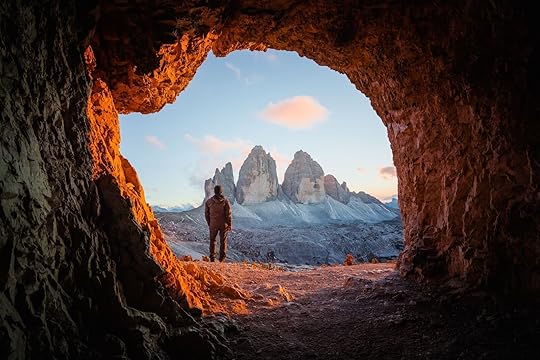
Photo: Smit /Shutterstock
When shopping for coverage, you’ll find two main approaches:
Base policy with adventure add-ons: Some insurers allow you to buy a standard policy, then tack on a “sports rider” or “adventure upgrade” for an extra cost. This model is useful for travelers who only occasionally participate in adventure sports.Plans with built-in adventure coverage: Other providers bundle a wide range of activities into their core policies. These are designed for people who regularly engage in adventure travel and want comprehensive protection without piecemeal add-ons. World Nomads offers this in its Explorer and Epic Plans. Another example is Global Rescue, which offers intensive policies designed for medical rescue that covers remote locations.Sport-specific plans: Look for scuba-specific plans, for example, if you’re heading on a dive trip.Which is better depends on your travel style. If you’re taking a once-in-a-lifetime ski trip, an upgrade might suffice. But if adventure sports are central to your lifestyle, a built-in policy saves time, guesswork, and often money.
World Nomads (and most well-known travel insurance providers) falls into the latter
Photo: Parilov /Shutterstock
World Nomads is one of the best-known providers in this space because its plans are specifically built for adventurers. The company offers coverage of more than 200 activities—from bungee jumping and surfing to trekking and scuba diving—without requiring separate riders.
Unlike some competitors, World Nomads lists covered activities upfront, so travelers can check whether their sport is included. They also allow you to extend coverage while already traveling, a major advantage for long-term adventurers who may change plans on the road.
While World Nomads is not always the cheapest option (though it often is – grab a quick quote to see what you’re looking at), its simplicity and breadth of coverage make them a favorite among backpackers, climbers, and digital nomads who like to blend work with play.
Altitude limits and how they factor into policies
Photo: Giorgio Peripoli /Shutterstock
A crucial but often overlooked detail in adventure travel insurance is altitude limits. Many insurers cap coverage for trekking or climbing at a specific elevation—often between 3,000 and 6,000 meters (19,685 feet).
This matters if you’re tackling high-altitude treks like Kilimanjaro (19,635 feet) or Everest Base Camp (17,598 feet). If your policy caps out at 3,500 meters (11,482 feet), any injuries sustained above that level won’t be covered. Similarly, mountaineering that requires specialized equipment may fall into a separate category requiring even higher-level coverage.
Always double-check the altitude limit in your policy documents. If your trek exceeds it, look for providers that specialize in high-altitude coverage. World Nomads, IMG, and Global Rescue, for example, all have options tailored for mountaineers.
Equipment liability insurance that typically needs a side policy
Photo: Aleksandr Grechanyuk /Shutterstock
Another gap to watch for is gear coverage. Standard travel insurance usually protects personal belongings against theft or damage, but coverage limits for specialized adventure equipment (like climbing ropes, skis, or scuba gear) are often low. For instance, a standard baggage policy might cover $1,000 total, with a per-item cap of $250. That won’t come close to replacing a full set of mountaineering equipment or a high-end camera lost on an expedition.
Travelers who bring expensive gear should consider supplemental equipment liability insurance. These side policies—sometimes offered by home insurers or specialized providers—protect against theft, loss, and damage to costly sports equipment. In some cases, outfitters or gear rental companies also require proof of liability coverage before allowing participation.
The best adventure travel policiesWhen it comes to adventure travel, a few providers consistently rise to the top:
World Nomads: Best overall for simplicity and breadth, covering 200+ activities without upgrades. Great for independent travelers and long-term trips.IMG (Patriot Adventure): Offers customizable policies with high-altitude and evacuation coverage. A solid option for climbers, trekkers, and skiers.Global Rescue: Known for elite evacuation services, including field rescue from remote regions. More expensive, but indispensable for expeditions to extremely remote or high-risk areas.Allianz with Adventure Upgrades: Allianz offers affordable base policies and optional riders for adventure sports. Good for casual adventurers who only need coverage occasionally, and mangeable via a convenient app.When choosing, weigh not just price but also the fine print: altitude caps, covered sports, and whether pre-existing conditions are excluded. 
Whistler Is Winter at Its Best. Here’s Why You Can’t Miss It This Season.
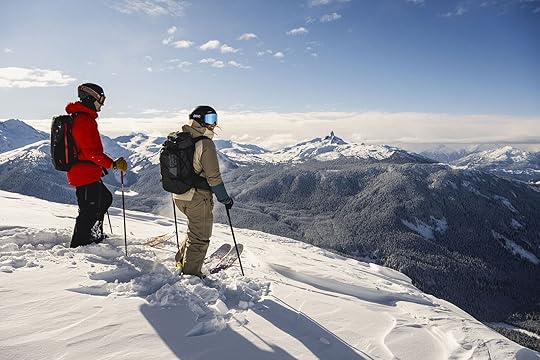
There’s no single Whistler visitor profile. Thrill-seekers, nature lovers, and food enthusiasts find their happy place here. So do travelers on the hunt for world-class cultural and luxury experiences. Bottom line: Whistler is the ultimate winter destination, no matter what you’re into. And winter is coming.
Getting to Whistler is easy. Direct air routes from major cities across the the US touch down on the daily at Vancouver International Airport. From the airport or downtown Vancouver, you can hop on a shuttle or arrange a private transfer for a splendidly scenic drive up the Sea to Sky Highway. The two-hour journey showcases beautiful British Columbia at its finest, featuring nonstop views of rugged Coast Mountains wilderness and the glittering depths of Howe Sound Fjord. Whistler’s compact village is pedestrian-only, so once you’ve arrived, enjoy strolling to award-winning restaurants, local boutiques, and a blizzard of winter activities, including easy access to lifts and gondolas.
Here’s why Whistler is perfect for your next winter trip — no matter who you are.
Double the mountains means double the fun.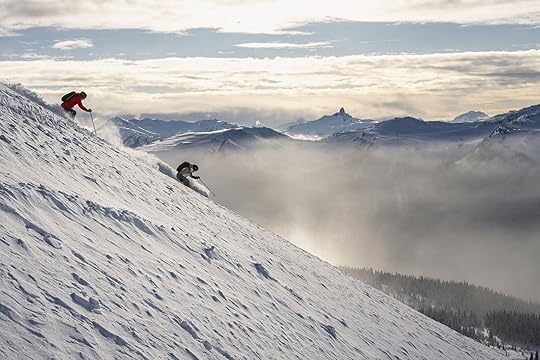
Photo: Tourism Whistler / Guy Fattal
Whistler’s reign as the largest ski resort in North America rests on the impressively massive shoulders of the Whistler and Blackcomb Mountains. These high alpine peaks are more than up to the task of providing skiers and snowboarders with some of the most exhilarating mountain experiences in the world.
With over 8,171 acres of skiable terrain — including 16 alpine bowls, three glaciers, world-class terrain parks, and 200+ marked trails — Whistler delivers exceptional options for every type of skier and rider. From steep chutes at the top of Blackcomb to scenic groomers like Springboard, every day brings a fresh chance to go big and test your limits. Bonus: The mountains are connected by a jaw-dropping 11-minute journey on the PEAK 2 PEAK Gondola.
You can stay longer…
Photo: Tourism Whistler / Mitch Winton
Running from November to April and beyond, Whistler has one of the longest and most reliable winter seasons on the planet. That prime coastal snow, unparalleled mountain terrain, and winning shoulder season conditions are a magical triple threat. It’s a no-brainer to hang out on the slopes and luxuriate in the Village for as long as possible on an extended stay.
Visiting from the US? Not only is Whistler open and welcoming to US travelers, but you’ve struck the vacation jackpot. The favorable exchange rate means your money really does go farther — $1 USD equals $1.40 CDN — so you can ski, stay, and play longer. And Whistler’s varied accommodations mean there’s a room, suite, or penthouse to suit everyone’s taste, style, and budget, sweetened by the promise of early booking discounts and deals to enjoy more savings. Yes, you can shred at Whistler Blackcomb without shredding your wallet. How? Commit early.
…save money…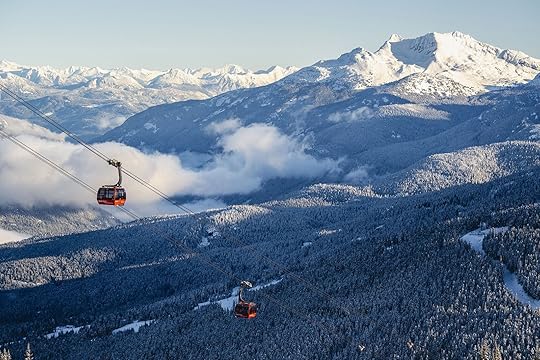
Photo: Tourism Whistler / Guy Fattal
Booking early for winter 2025-26 in Whistler ensures the best rates, prime accommodation options, and peace of mind for a stress-free ski vacation. Epic Passes and Whistler Blackcomb Day Passes are your golden tickets — but they’re only available until the start of December. Prices go up as winter gets closer, and those day-of lift ticket prices can be triple the price of some pass options. Committing early means your future self will thank you.
…and do more.
Photo: Tourism Whistler / Claire Lang
Challenge yourself to get out of your comfort zone with thrilling world-class multi-sport ways to play all day — on and off the slopes — and really make the most of Whistler’s spectacular natural environment.
To start, explore Whistler and the Callaghan Valley’s incredible winter landscapes by snowshoe, snowmobile, or cross-country ski tours. Play with different perspectives by soaring above and through snow-covered forests on North America’s highest and longest ziplines, bungee jumping from a bridge high above the glacial-fed Cheakamus River, or boarding a helicopter for an unforgettable sightseeing flight over the rugged peaks, ancient glaciers, and stunning ice formations of the Coast Mountains.
Even more thrills await when you slide down the world’s fastest ice track in a bobsleigh or on a skeleton sled at the Whistler Sliding Centre, the former 2010 Winter Olympic Games venue. Whatever you do, there’s a big, wintry world to explore, and it all promises to be epic.
The adventure never ends.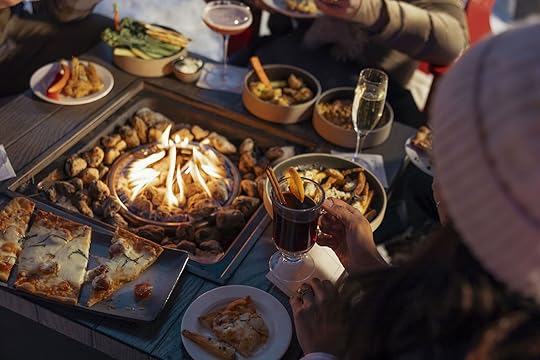
Photo: Tourism Whistler / Justa Jeskova
In Whistler, the mountain fun doesn’t stop after your final turns on the slope or sky-high excursion. The party’s just getting started with the bumping après that Whistler is known for. Scope out live music at Garibaldi Lift Company or immerse yourself in the see-and-be-seen crowd on Longhorn Saloon’s expansive heated outdoor patio at the base of Whistler Blackcomb.
After swapping ski boots for Blundstones (the local footwear of choice), take the “Village Stroll” along Whistler’s European-inspired, pedestrian-only streets to enjoy people-watching and world-class culinary experiences under the twinkle of fairy lights. Indulge in retail therapy and peruse homegrown Canadian boutiques like Mt. Waddington Outdoors, Abigail Lifestyle, Roots, and Lululemon. Or leave the world behind and soak in the silent sanctuary of Scandinave Spa Whistler. A few cycles of soothing Nordic hydrotherapy always leave guests feeling renewed and rejuvenated for the next day’s adventures.
Should that next day call for a dash of culture, Whistler’s got you covered with an impressive arts scene that few mountain towns can match. The architectural power of the stunning Audain Art Museum, a first-class institution, is equal to the gallery’s incredible displays of artwork by some of British Columbia’s most prominent artists. A stone’s throw away, the living history and culture of the Squamish and Lil’wat First Nations is proudly presented in a beautiful wood and glass Squamish Lil’wat Cultural Centre. The gallery and museum connect the First Peoples of this valley with locals and guests through multimedia displays, tours, and hands-on craft workshops, forging respect and understanding across cultures.
This winter, ease into the fresh tracks groove and take your time exploring Whistler’s unparalleled ski terrain and winter adventure opportunities. Need more inspo? Check out these insider tips — and start planning your ultimate Whistler winter adventure. 
Lo Mejor Del Invierno Está En Whistler. Te Contamos Por Qué No Te Lo Puedes Perder Esta Temporada.

Whistler no es un destino enfocado en un solo tipo de viajero. Si eres un amante de la adrenalina, un fanático de la naturaleza o un apasionado de la buena comida, aquí te sentirás como en casa. Lo mismo ocurre con quienes buscan experiencias culturales o lujo de primer nivel. En pocas palabras, y sin importar tu estilo de viaje, Whistler es el destino invernal definitivo. ¡Y el invierno ya está a la vuelta de la esquina!
Llegar a Whistler es muy fácil. Hay vuelos directos que conectan destinos como Ciudad de México, Guadalajara o Cancún con el Aeropuerto Internacional de Vancouver durante todo el año. Desde ahí, puedes tomar un autobús o un transporte privado y disfrutar del espectacular camino por la Sea to Sky Highway. Durante dos horas de viaje verás la belleza de Columbia Británica en todo su esplendor, con vistas interminables de las Montañas Costeras y las brillantes profundidades del fiordo Howe Sound. El pueblo de Whistler es completamente peatonal, así que una vez ahí, podrás caminar hasta restaurantes galardonados, boutiques locales y una gran variedad de actividades invernales, con fácil acceso a góndolas y telesillas.
Si buscas experimentar un verdadero paraíso invernal, aquí te contamos por qué deberías dirigirte al norte en esta temporada de nieve.
Dos montañas significa el doble de diversión.
Foto: Tourism Whistler / Guy Fattal
La soberanía de Whistler como el resort de esquí más grande de Norteamérica se sostiene sobre las imponentes laderas de las montañas Whistler y Blackcomb. Estas cumbres alpinas están más que listas para ofrecer a esquiadores y snowboarders algunas de las experiencias de montaña más emocionantes en el mundo.
Con más de 3,307 hectáreas de terreno esquiable —incluyendo 16 cuencas alpinas, tres glaciares, parques de nieve de clase mundial y más de 200 senderos señalizados— Whistler ofrece opciones excepcionales para todo tipo de esquiadores y practicantes de snowboard. Desde los empinados descensos desde la cima de Blackcomb hasta pistas panorámicas como Springboard, cada día es una nueva oportunidad para desafiar tus límites. Como un extra: las montañas están conectadas por un impresionante recorrido de 11 minutos en la PEAK 2 PEAK Gondola.
Puedes quedarte más tiempo…
Foto: Tourism Whistler / Mitch Winton
Whistler ofrece a los viajeros mexicanos la mejor aventura invernal: días de nieve en polvo de clase mundial y lo mejor de la temporada de esquí canadiense. Y tienes tiempo de sobra para disfrutarlo. Desde noviembre hasta abril y más allá, Whistler tiene una de las temporadas invernales más largas y confiables del planeta. La nieve costera de primera calidad, un terreno montañoso incomparable y las excelentes condiciones durante la temporada baja, son un triple atractivo que parece arte de magia.
En cuanto llegues, vas a querer prolongar tu estancia lo más posible para sacarle todo el provecho posible a las pistas y a los lujos del Village. Lo mejor es que la variedad de alojamientos de Whistler te asegura que habrá una habitación, suite o penthouse adaptada a tus gustos, estilo y presupuesto, con descuentos por reservas anticipadas que te permiten ahorrar aún más. Sí, puedes disfrutar de Whistler Blackcomb sin gastarte un dineral. ¿Cómo? Reservando con anticipación.
Ahorrar dinero…
Foto: Tourism Whistler / Guy Fattal
Reservar con tiempo para esta temporada invernal en Whistler garantiza las mejores tarifas, las opciones de alojamiento más convenientes y la tranquilidad de unas vacaciones de esquí sin estrés. Los Epic Passes y los Whistler Blackcomb Day Passes son tus boletos dorados, pero solo están disponibles hasta principios de diciembre. Los precios suben a medida que se acerca el invierno y los boletos de telesillas para un solo día pueden terminar costando hasta tres veces más que algunos pases. Si te comprometes con anticipación, tu futuro yo te lo agradecerá.
Y hacer muchas más cosas.
Foto: Tourism Whistler / Claire Lang
Atrévete a salir de tu zona de confort con actividades deportivas de clase mundial, dentro y fuera de las pistas, y aprovecha al máximo el espectacular entorno natural de Whistler.
Para empezar, explora los increíbles paisajes invernales de Whistler y el valle de Callaghan en raquetas de nieve, motonieve, o esquí de fondo. Cambia de perspectiva sobrevolando los bosques nevados con las tirolesas más altas y largas de Norteamérica, lánzate en bungee desde un puente sobre el río Cheakamus alimentado por glaciares, o sube a un helicóptero para un vuelo inolvidable sobre picos escarpados, glaciares milenarios y las impresionantes formaciones de hielo de las Montañas Costeras.
Más emociones te esperan al deslizarte por la pista de hielo más rápida del mundo en un bobsleigh o en un trineo skeleton en el Whistler Sliding Centre, sede de los Juegos Olímpicos de Invierno de 2010. Hagas lo que hagas, hay un enorme mundo invernal por explorar que promete ser épico.
La aventura nunca termina.
Foto: Tourism Whistler / Justa Jeskova
La diversión en la montaña no se acaba con tus últimos descensos o excursiones por las alturas. La fiesta apenas comienza con el famoso bumping après-ski de Whistler. Disfruta de música en vivo en Garibaldi Lift Company o sumérgete en el ambiente social del amplio patio techado de Longhorn Saloon, al pie de Whistler Blackcomb.
Después de cambiar las botas de esquí por unos Blundstone (el calzado local por excelencia), date una vuelta por las calles peatonales de estilo europeo del Village y disfruta de la gente y de las experiencias culinarias de clase mundial bajo el resplandor de las luces navideñas. Date un gusto comprando y explorando en boutiques canadienses como Mt. Waddington Outdoors, Abigail Lifestyle, Roots y Lululemon. O desconéctate y relájate en el silencio de Scandinave Spa Whistler. Un par de ciclos de hidroterapia nórdica son suficientes para dejarte renovado y listo para la aventura del día siguiente.
Si tu siguiente día pide un toque cultural, Whistler te ofrece una impresionante escena artística que pocos pueblos de montaña pueden igualar. El poderoso diseño del Audain Art Museum es igual de impactante que las exhibiciones que alberga en su interior, con obras de los artistas más destacados de la Columbia Británica. Muy cerca, la historia viva y la cultura de las Primeras Naciones Squamish y Lil’wat se presentan con orgullo en el hermoso Squamish Lil’wat Cultural Centre, conectando a los pueblos originarios con los locales y los visitantes a través de exhibiciones multimedia, recorridos y talleres artesanales, forjando el respeto y la comprensión entre culturas.
Este invierno, déjate llevar por el encanto de las pistas frescas y explora con calma el incomparable terreno de esquí y las oportunidades de aventura invernal que ofrece Whistler. ¿Necesitas más inspiración? Echa un vistazo a estos consejos de expertos y comienza a planear tu aventura invernal definitiva en Whistler. 
Whistler Is Winter at Its Best. Here’s Why You Can’t Miss It This Season.

There’s no single Whistler visitor profile. Canadians of all persuasions — thrill-seekers, nature lovers, and food enthusiasts — all find their happy place here. So do those on the hunt for cultural and luxury experiences. Bottom line: Whistler is the ultimate winter destination, no matter what you’re into. And winter is coming.
Whether you’re road-tripping from BC or Alberta, or flying into Vancouver International Airport from across Canada, the journey is part of the adventure. From Vancouver, the stunningly beautiful Sea to Sky Highway delivers you to Whistler in under two hours, with nonstop views of the rugged Coast Mountains wilderness and the glittering depths of Howe Sound Fjord along the way. Once you arrive, Whistler’s pedestrian-only village makes it easy to stroll between award-winning restaurants, cosy shops, and, of course, endless winter activities with quick access to lifts and gondolas.
Here’s why you should rush to Whistler this snowy season for a trip to remember.
Double the mountains means double the fun.
Photo: Tourism Whistler / Guy Fattal
Whistler’s reign as the largest ski resort in North America rests on the impressively massive shoulders of the Whistler and Blackcomb Mountains. These high alpine peaks are more than up to the task of providing skiers and snowboarders with some of the most exhilarating mountain experiences in the world.
With over 8,171 acres of skiable terrain — including 16 alpine bowls, three glaciers, world-class terrain parks, and 200+ marked trails — Whistler delivers exceptional options for every type of skier and rider. From steep chutes at the top of Blackcomb to scenic groomers like Springboard, every day brings a fresh chance to go big and test your limits. Bonus: The mountains are connected by a jaw-dropping 11-minute journey on the PEAK 2 PEAK Gondola.
You can stay longer…
Photo: Tourism Whistler / Mitch Winton
Running from November to April and beyond, Whistler has one of the longest and most reliable winter seasons in Canada. That prime coastal snow, unparalleled terrain, and winning shoulder season conditions are a magical triple threat. It’s a no-brainer to hang out on the slopes and luxuriate in the Village for as long as possible on an extended stay. Plus, staying longer means you can enjoy midweek skiing when the mountains feel like your private playground.
Whistler’s varied accommodations mean there’s a room, suite, or penthouse to suit everyone’s taste, style, and budget, sweetened by the promise of early booking discounts and deals to enjoy more savings. Whether you’re coming from across the province or across the country, travelling within your own backyard has never been so rewarding.
…save money…
Photo: Tourism Whistler / Guy Fattal
Booking early for winter 2025-26 in Whistler ensures the best rates, prime accommodation options, and peace of mind for a stress-free ski vacation. Epic Passes and Whistler Blackcomb Day Passes are your golden tickets — but they’re only available until the start of December. Prices go up as winter gets closer, and those day-of lift ticket prices can be triple the price of some pass options. Committing early means your future self will thank you.
…and do more.
Photo: Tourism Whistler / Claire Lang
Challenge yourself to get out of your comfort zone with thrilling world-class multi-sport ways to play all day — on and off the slopes — and really make the most of Whistler’s spectacular natural environment.
To start, explore Whistler and the Callaghan Valley’s incredible winter landscapes by snowshoe, snowmobile, or cross-country ski tours. Play with different perspectives by soaring above and through snow-covered forests on North America’s highest and longest ziplines, bungee jumping from a bridge high above the glacial-fed Cheakamus River, or boarding a helicopter for an unforgettable sightseeing flight over the rugged peaks, ancient glaciers, and stunning ice formations of the Coast Mountains.
Even more thrills await when you slide down the world’s fastest ice track in a bobsleigh or on a skeleton sled at the Whistler Sliding Centre, the former 2010 Winter Olympic Games venue. Whatever you do, there’s a big, wintry world to explore, and it all promises to be epic.
The adventure never ends.
Photo: Tourism Whistler / Justa Jeskova
In Whistler, the mountain fun doesn’t stop after your final turns on the slope or sky-high excursion. The party’s just getting started with the bumping après that Whistler is known for. Scope out live music at Garibaldi Lift Company or immerse yourself in the see-and-be-seen crowd on Longhorn Saloon’s expansive heated outdoor patio at the base of Whistler Blackcomb.
After swapping ski boots for Blundstones (the local footwear of choice), take the “Village Stroll” along Whistler’s European-inspired, pedestrian-only streets to enjoy people-watching and world-class culinary experiences under the twinkle of fairy lights. Indulge in retail therapy and peruse homegrown Canadian boutiques like Mt. Waddington Outdoors, Abigail Lifestyle, Roots, and Lululemon. Or leave the world behind and soak in the silent sanctuary of Scandinave Spa Whistler. A few cycles of soothing Nordic hydrotherapy always leave guests feeling renewed and rejuvenated for the next day’s adventures.
Should that next day call for a dash of culture, Whistler’s got you covered with an impressive arts scene that few mountain towns can match. The architectural power of the stunning Audain Art Museum, a first-class institution, is equal to the gallery’s incredible displays of artwork by some of British Columbia’s most prominent artists. A stone’s throw away, the living history and culture of the Squamish and Lil’wat First Nations is proudly presented in a beautiful wood and glass Squamish Lil’wat Cultural Centre. The gallery and museum connect the First Peoples of this valley with locals and guests through multimedia displays, tours, and hands-on craft workshops, forging respect and understanding across cultures.
This winter, ease into the fresh tracks groove and take your time exploring Whistler’s unparalleled ski terrain and winter adventure opportunities. Need more inspo? Check out these insider tips — and start planning your ultimate Whistler winter adventure. 
Matador Network's Blog
- Matador Network's profile
- 6 followers



